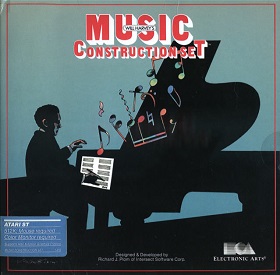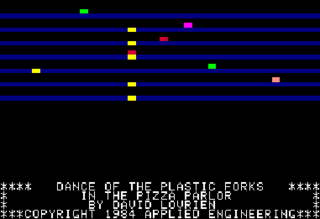Related Research Articles

The Apple II series is a family of home computers, one of the first highly successful mass-produced microcomputer products, designed primarily by Steve Wozniak, manufactured by Apple Computer, and launched in 1977 with the original Apple II.

The Apple II is an 8-bit home computer and one of the world's first highly successful mass-produced microcomputer products. It was designed primarily by Steve Wozniak; Jerry Manock developed the design of Apple II's foam-molded plastic case, Rod Holt developed the switching power supply, while Steve Jobs's role in the design of the computer was limited to overseeing Jerry Manock's work on the plastic case. It was introduced by Jobs and Wozniak at the 1977 West Coast Computer Faire, and marks Apple's first launch of a personal computer aimed at a consumer market—branded toward American households rather than businessmen or computer hobbyists.

The Commodore 64, also known as the C64, is an 8-bit home computer introduced in January 1982 by Commodore International. It has been listed in the Guinness World Records as the highest-selling single computer model of all time, with independent estimates placing the number sold between 12.5 and 17 million units. Volume production started in early 1982, marketing in August for US$595. Preceded by the VIC-20 and Commodore PET, the C64 took its name from its 64 kilobytes(65,536 bytes) of RAM. With support for multicolor sprites and a custom chip for waveform generation, the C64 could create superior visuals and audio compared to systems without such custom hardware.

A motherboard is the main printed circuit board (PCB) in general-purpose computers and other expandable systems. It holds and allows communication between many of the crucial electronic components of a system, such as the central processing unit (CPU) and memory, and provides connectors for other peripherals. Unlike a backplane, a motherboard usually contains significant sub-systems, such as the central processor, the chipset's input/output and memory controllers, interface connectors, and other components integrated for general use.

A sound card is an internal expansion card that provides input and output of audio signals to and from a computer under the control of computer programs. The term sound card is also applied to external audio interfaces used for professional audio applications.
A music tracker is a type of music sequencer software for creating music. The music is represented as discrete musical notes positioned in several channels at discrete chronological positions on a vertical timeline. A music tracker's user interface is usually number based. Notes, parameter changes, effects and other commands are entered with the keyboard into a grid of fixed time slots as codes consisting of letters, numbers and hexadecimal digits. Separate patterns have independent timelines; a complete song consists of a master list of repeated patterns.

The MOS Technology 6581/8580 SID is the built-in programmable sound generator chip of Commodore's CBM-II, Commodore 64, Commodore 128 and Commodore MAX Machine home computers. It was one of the first sound chips of its kind to be included in a home computer prior to the digital sound revolution.

The Apple IIGS, the fifth and most powerful of the Apple II family, is a 16-bit personal computer produced by Apple Computer. While featuring the Macintosh look and feel, and resolution and color similar to the Amiga and Atari ST, it remains compatible with earlier Apple II models. The "GS" in the name stands for "Graphics and Sound," referring to its enhanced multimedia hardware, especially its state-of-the-art audio.

The TI-99/4 and TI-99/4A are home computers released by Texas Instruments in 1979 and 1981, respectively. Based on the Texas Instruments TMS9900 microprocessor originally used in minicomputers, the TI-99/4 was the first 16-bit home computer. The associated video display controller provides color graphics and sprite support which were only comparable with those of the Atari 400 and 800 released a month after the TI-99/4.

The Mockingboard is a sound card built by Sweet Micro Systems for the Apple II series of microcomputers. It improves on the Apple II's limited sound capabilities, as did other Apple II sound cards.
Ensoniq Corp. was an American electronics manufacturer, best known throughout the mid-1980s and 1990s for its musical instruments, principally samplers and synthesizers.

Will Harvey's Music Construction Set (MCS) is a music composition notation program designed by Will Harvey for the Apple II and published by Electronic Arts in 1983. Harvey wrote the original Apple II version in assembly language when he was 15 and in high school. MCS was conceived as a tool to add music to his previously published game, an abstract shooter called Lancaster for the Apple II.

Applied Engineering, headquartered in Carrollton, TX, was a leading third-party hardware vendor for the Apple II series of computers from the early 1980s until the mid-1990s.

The AY-3-8910 is a 3-voice programmable sound generator (PSG) designed by General Instrument in 1978, initially for use with their 16-bit CP1610 or one of the PIC1650 series of 8-bit microcomputers. The AY-3-8910 and its variants were used in many arcade games—Konami's Gyruss contains five—and pinball machines as well as being the sound chip in the Intellivision and Vectrex video game consoles, and the Amstrad CPC, Oric-1, Colour Genie, Elektor TV Games Computer, MSX, and later ZX Spectrum home computers. It was also used in the Mockingboard and Cricket sound cards for the Apple II and the Speech/Sound Cartridge for the TRS-80 Color Computer.

Passport Designs Inc. was a software company that created early music production software, such as the pre-MIDI SoundChaser in 1982. Other programs included Master Tracks Pro and Encore.
Bank Street Music Writer is an application for composing and playing music for the Atari 8-bit family, Apple II, Commodore 64 and IBM PC. It was written by Glen Clancy and published by Mindscape. The original Atari version, developed under the name "Note Processor," was released in 1985 and uses the computer's on-board sound chip to produce four-voice music recordings. The Commodore 64 version also uses that system's sound hardware, while the Apple and IBM PC versions require a sound card which was included in the retail box, or alternately use the three-voice sound chip standard with all Tandy and IBM PCjr computers.

E-mu Systems was a software synthesizer, audio interface, MIDI interface, and MIDI keyboard manufacturer. Founded in 1971 as a synthesizer maker, E-mu was a pioneer in samplers, sample-based drum machines and low-cost digital sampling music workstations.

The Amiga 1200, or A1200, is a personal computer in the Amiga computer family released by Commodore International, aimed at the home computer market. It was launched on October 21, 1992, at a base price of £399 in the United Kingdom and $599 in the United States.

Phasor is a stereo music, sound and speech synthesizer created by Applied Engineering for the Apple II family of computers. Consisting of a sound card and a set of related software, the Phasor system was designed to be compatible with most software written for other contemporary Apple II cards, including the Sweet Micro Systems Mockingboard, ALF's Apple Music Synthesizer, Echo+ and Applied Engineering's earlier card Super Music Synthesizer.

ALF Products Inc., or ALF, was a Colorado company primarily known for its computer-controlled music synthesizers and floppy disk supplies and duplicators.
References
- ↑ M. M. Novak (11 November 1984). The Commodore 64 in Action: Sound, Graphics & Filing. Macmillan International Higher Education. ISBN 978-1-349-07506-5.
- ↑ Raskin, Jef (1978). Apple II Basic Programming Manual (PDF). Apple Computer. p. 123.
- ↑ N.B. Scrimshaw (11 November 2013). An Introduction to the Commodore 64: Adventures in Programming. Birkhäuser. pp. 52–. ISBN 978-1-4899-6787-9.
- ↑ ALF Products advertisement, "Apple Music", Creative Computing, Vol. 6 No. 2, Feb. 1980 pg. 103. Retrieved 2013-04-11.
- ↑ North, Steve, "ALF/Apple Music Synthesizer", Creative Computing, Vol. 5 No. 6, June 1979 pg. 102. Retrieved 2013-04-11.
- ↑ American Micro Products advertisement, "Juke Box Synthesizer", Byte, Vol. 5 No. 6, Jun. 1980 pg. 177. Retrieved 2020-02-24.
- ↑ Applied Engineering 1985 Catalog pg 11. Retrieved 2019-11-10.
- ↑ Applied Engineering 1986 Summer/Fall Catalog pg 12. Retrieved 2019-11-10.
- ↑ "AlphaSyntauri". Audioimprov.com. 2012-04-28. Retrieved 2016-06-27.
- ↑ Jigour, Robin; Kellner, Charlie; Lapham, Ellen. "The alphaSyntauri Instrument: A Modular and Software Programmable Digital Synthesizer System". Philadelphia: IEEE Computer Society, 1981.
- ↑ Vail, Mark. Vintage Synthesizers, p. 91-92. San Francisco: Miller Freeman Books, 2000
- ↑ "TRON's Apple Sound". inCider. No. 1. January 1983. p. 24.
- ↑ Hogan, Thom (1981-07-27). "Two keyboard synthesizers for Apple". InfoWorld.
- ↑ "Sonic Blaster Manual 1.2" (PDF). Retrieved December 12, 2017.[ permanent dead link ]